Today, I would like to tell you all about the EasyScales Visual Guides, a patent pending product by Jo Tee! Jo Tee is a creative piano teacher from Singapore.
Here is how it works:
Just place the EasyScale behind the black keys along the fall board, and then students can visually see the scale and its fingering. The blue numbers are for the RH, and the red is for the LH. The cards show two octaves instead of one — which is great because I always skip teaching one-octave scales in favor of teaching two octaves right off the bat.
The set includes 20 cards that are two-sided, for all 12 major and 12 minor scales (harmonic and melodic forms). The cards align perfectly to the piano keys.
Jo Tee also included a blank scale card in the set, which is perfect for games and activities for students to practice dictating the scale using glass gems or other markers. Here is a picture of an example activity from the EasyScales facebook page:
Below is a photo of the color-coded guide for finding the right card for each scale, which also serves as a way to store and protect the cards when they are not in use.
The whole concept of EasyScales is not only a very clever idea, but it is also very well executed! Learning scales and scale fingering is a very visual activity (at least until it enters motor memory), so it makes perfect sense to give students a visual guide. Visual guides are effective because they actually prevent mistakes until the scale becomes memorized. And it sure beats verbal correction or using a scale book. 🙂 I am looking forward to using these with my students for many years to come!
EasyScales can be ordered from Jo Tee’s websites here. EasyScales cost 29.90 in Singapore dollars, which is approximately $25 in USD (plus shipping).
Disclosure: I was sent a free copy of the EasyScales to try out, but was not required to write a positive review. As always, my reviews contain my honest opinions!
GIVEAWAY: Jo Tee has generously offered the chance for THREE lucky winners to win a free set of EasyScales visual guides! To enter the giveaway, leave a comment on this post before midnight EST on Thursday, October 4 with a tip or idea about teaching students their scales. 🙂


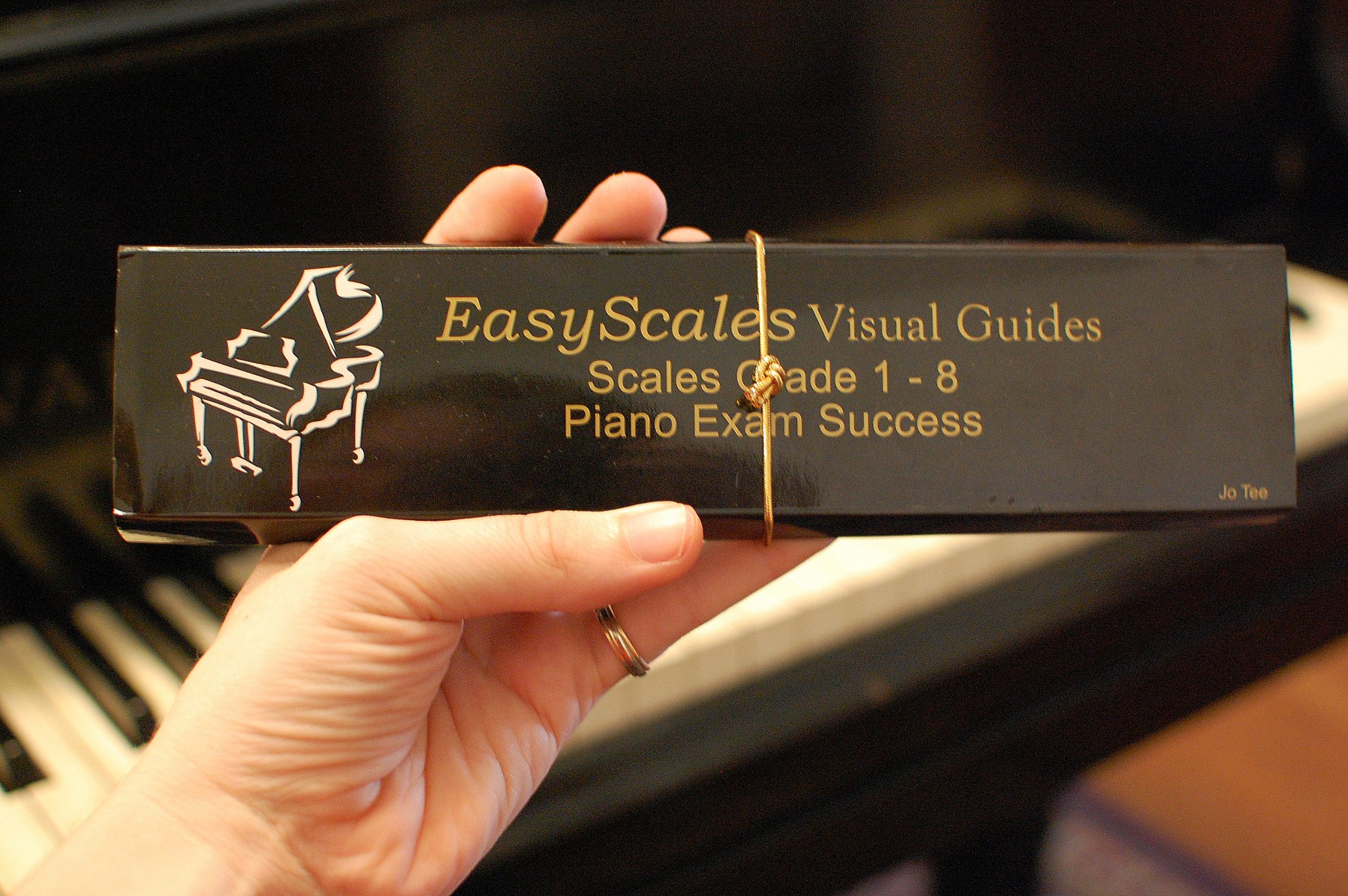
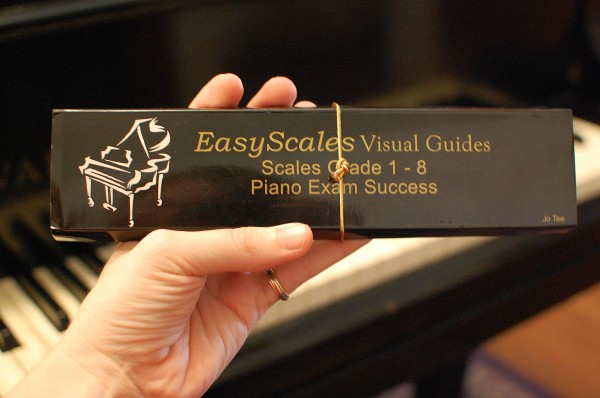
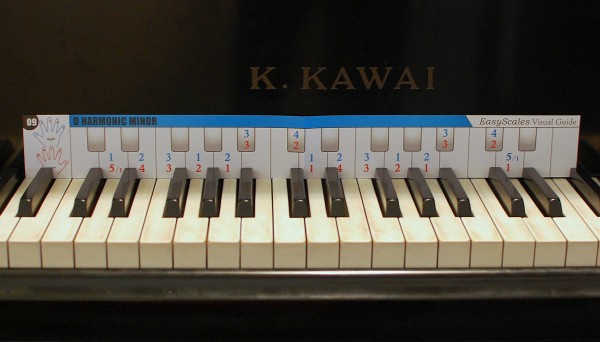
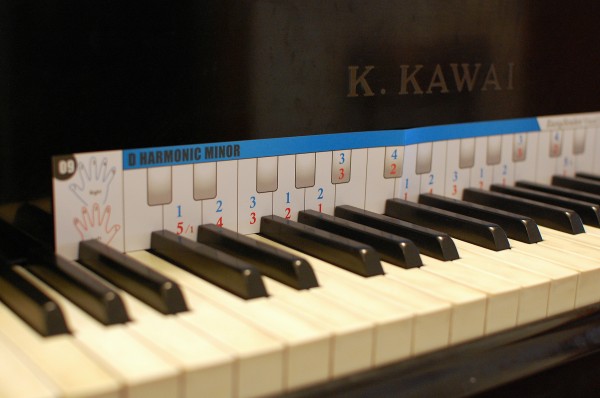

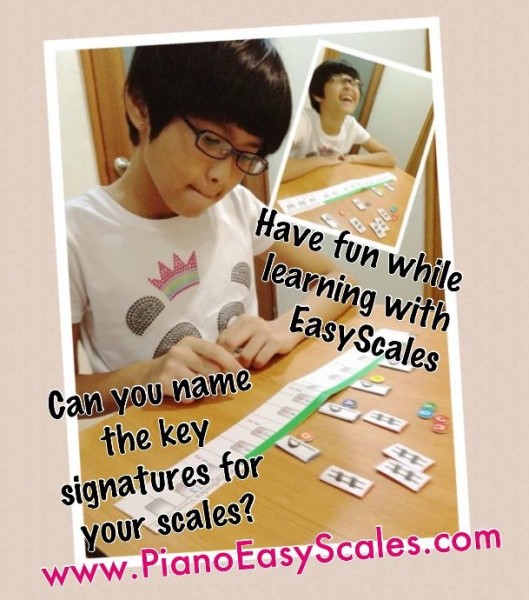
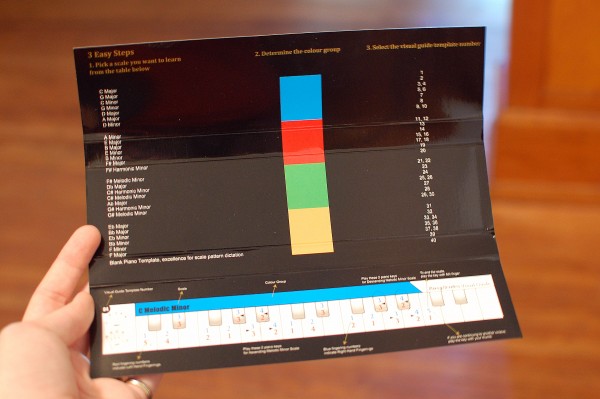
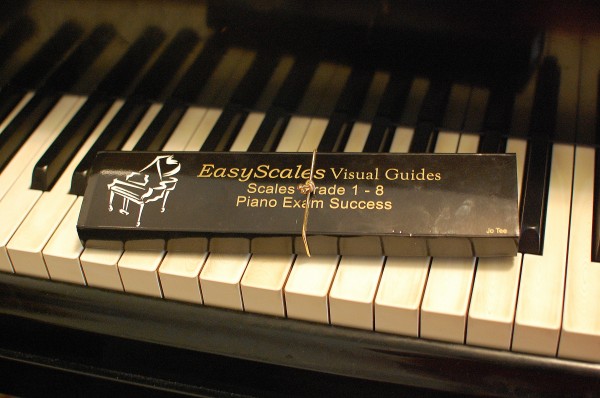
I try to explain to my students why we do scales, so that they are more motivated. I also try not to overload them with scales and things like that so that they hate them. 🙂
Joy, did you mean to say the 20th of September, or was that the 27th? Thank you!
Oh now I see it is changed to Oct. 4th. Thanks!
Yes, that was my mistake! It’s fixed now. 🙂
These are amazing! What a simple, yet brilliant, idea.
Oh I seriously need a set of these easy Scales. I teach many kids with learning disabilities! My Fun Trick for scales is to name a movie plot and they must supply the background music..eg the movie is about a dog who lost his bone and then finds it. Hopefully they play me their minor of the week followed by the major..they are allowed to use any rhythm and tempo for this game.
Hi
I saw this from my teacher’s studio.
It is so clear and easy to see the pattern of the scales.
Hope I can get one!
I think that these visual helps are excellent for so many students! I also like to use black & white scale blocks for students to build a scale using whole and half steps: http://www.wolfpiano.com/bagoblocks.html
Thanks for sharing this resource for teachers, Joy!
After teaching white key pentascales I have students pretend like a shark bit off their pinkies (finger 5) for a few weeks. After demonstrating that the first 4 notes of a C scale (tetrachord) + the first 4 notes of a G scale (tetrachord)= 1 8va C scale, students play the notes of all white key 1 8va scales using fingers LH 4321 RH 1234 following the circle of 5ths. I think this solidifies for them the pattern of keys to play & the sound of a major scale so they can focus better on the technical aspects of finger crossing later. These cards would be a great help to introduce scale fingering!
Thanks for hosting this giveaway! These definitely look like they could be helpful for my students!
I just recently found your website, and am enjoying looking through the different teaching resources you have – especially your printables! I am planning on using some of them in the near future. 🙂
Having two sets of these cards would be great – one for on the piano during lessons and another in the waiting room so students could play pretend piano on the cards to review the fingerings!
What a wonderful idea!! I might just enjoy teaching scales with this product!
I love the idea of an incentive box for learning scales and other important memorization tools!
What a wonderful resource!
I start my young students with 5-finger patterns and cover most major and minor keys, by the time they encounter scales they’re easy! Working with the W and H step pattern seems to make scales easier for my students as well. Would love to add this tool to my teaching materials!
I just found your blog last week and I am loving everything on it! And these scale cards look awesome! I find that practicing the scales on a flat surface first helps- especially if you have them chunk out the fingers in groups of 2’s and 3’s so that they get the feel for when the thumb crosses under.
I have had a lot of success with grouping scales according to fingering rules. Group 1=CGDAE (white key rule)
Group 2=B F# C# F (black key rule)
Group 3=Ab Bb Eb (RH black key rule, LH rocket rule 3214321)
I am a visual learner – where were these when I was a kid?!
One trick I use to teach scales with lots of black keys is this: hold up two fingers as if to indicate the number two. These two fingers play the sets of two black keys. Similarly, hold up three fingers as if to indicate the number three. These three fingers play the sets of three black keys. Thumbs take care of the white keys.
After teaching pentascales, I like to use scale skeletons to teach scales. Although, this product looks like it would be a great addition to my teaching studio!
Wow, very cool! I keep a scales progress page in each student’s folder so they can get excited about checking off each new one learned. I also try to let them hear me practicing scales and exercises as often as possible.
To help with fingering, I have students play the fingerings in blocks: fingers 1, 2, and 3 together in a block and then fingers 1,2, 3, and 4- 5 if we are to the end of the scale. It really unlocks the concept for some students.
What a great resource for visual learners! We so often seem to present information orally and by demonstration and expect students to remember it. Even writing down fingering doesn’t help that much for some students, and scale books can look overwhelming. Love it!
This is nothing groundbreaking of course, but when students struggle with the thumb-under movement (or when they twist their whole arm in order to reach with the thumb), I have them practice the thumb-under movement away from the piano. We notice just how much the thumb can actually do without turning the whole hand over. When we come back to the piano, we practice a lot of four-note scales where we play with 1 2 3 1 and prepare the hand for the rest of the scale without actually playing.
I would love one 🙂 I have my students practice writing the fingering for scales on paper first and then they practice them on the piano.
What a cool resource! I’ve just stuck to having the kids memorize the pattern of whole and half steps, and then we do 4 octaves to give them lots of chances to master the scale fingering!
I love the idea of teaching scales visually! I would love a set of these to use with my students.
What a creative idea! Would love to add these to my studio’s teaching resources.
Thank you Joy for such a helpful and encouraging website. I look forward to reading your posts each week!
Victoria
Very effective for the visual learner. Thanks for posting these new, innovative ideas. I will encourage my student’s parents to invest in a set for their child. They should have one at home and not just for the lesson.
These are great! I’m thinking how much easier learning scales would be for my students than they were for me. Thanks so much for sharing, Joy!
I like Cindy’s idea about using these in the waiting area. Also, as Babette mentioned, these would be great for visual learners (I am a visual learner and would have enjoyed these!). I teach scales by rote and have my students say the fingering. I also enjoy using the “black key” rule with my students: fingers 2 and 3 on the 2 black keys, and fingers 2, 3, 4 on the 3 black keys, and have students block the scale before playing each note individually. Thanks for all you do, Joy!
I am a new teacher. I have been starting children on 5 finger c and g scales. I have a student who is just starting PA 2A and feel he is ready to start full scales. The method book show using whole and half steps that I was planning on trying.
I like to make learning scales a competition between two students who are on the same level. Kids love games!
Sounds cool….I hope I win this!!
My comment for how I teach scales is that I always teach LH and RH in contrary motion, rather than parallel. For example, I teach the RH from C up to C, then the LH from C down to C. Students see how the fingering is essentially the same right away, rather than believing my explanation that it is 🙂
Wow – I was going to add some of my own tips, but most of the teachers here have already covered them! I’m going to take time to re-read through the rest of these suggestions. Like most, I’ve started getting my students into two octave scales instead of one – it just makes more sense!
Love this idea! I am always looking for better ways of teaching scales. I like the FJH Scale duet books. Makes it more enjoyable for the kids.
Wow, so awesome to see our very own Sngaporean talent here. ..definitely getting 1 set to support. Keep it up!!! 🙂
Love this! In my studio, we use tiles (letters, #s and bs written on them) to spell out the scales. We use them on laminated cardstock keyboards as well as on laminated cardstock staves. My students learn how to build scales using the Circle of Fifths/Fourths. Activities with the tiles reinforce when to add sharps or flats. What I really love about this EasyScales Visual Guides Set is that it helps the student understand the fingering of the scales in such a clear and easy way at the actual keyboard!
It must be a perfect tool of all my stuents. SAVE TIME, SAVE MIND,
what a wonderful product
I present scales both as groups depending on their fingering, and as patterns of whole and half steps.
These look like a great tool for teaching scales. It would be great to win so I can give them a try!
I love these. I think they would be especially helpful for our students who are visual learner. I would enjoy using thesse in my studio. Thanks for the chance to win them.
This is so resourceful!!
The scale cards look to be very useful for students! I would love to give them a try. I do use Susan Paradis’ visual scales, and the students really benefit from them. I also have the students practice creating scales using a printed keyboard and squinkies. This really helps them understand the pattern of whole and half steps, and it’s fun!
I use TCW’s technic gymnastics as a resource when teaching scales. Very useful! This would be helpful as well
I usually teach pentascales by drawing five boxes in a straightline on the students assignment sheet and coloring in the boxes that are the black keys. This gets them all over the keyboard very quickly with out worrying about sharps or flats. (they only have to name the first note). For crossing the finger under I assign them to improvise a short “batman motive” using half steps. The only rule is that only fingers 2 and 3 may play black keys and only the thumb can play on the white. I have used Major Scale Picture workbook Glenna Battson. It gives a cute picture and fingerings to illustrate every scale as well as a workbook page for fingerings and key signatures. I find that teaching by wrote or scale shape and then figuring out sharps and flats inductively is very helpful!!!
I also teach pentascales in order of how the feel. C and G together, A and D together… etc… I give a very big incentive (usually an ice cream gift card) for memorizing all 12 pentascales.
I discovered another awesome resource today called Scales, patterns and improvs by Hal Leonard that I just ordered and can’t wait to try out. It will have them playing improvs and songs in all twelve keys… I can’t wait to see how that helps with sight reading ability!
I try to give my students a visual picture of the scales. This set looks like it would be a great addition to helping them have a visual picture of the notes being sharp or flat or white… and the fingering all there together I can’t wait to try these scale sheets.
Wow! These visual guides look great!
Having a chart to check off scales as they are learned seems to help my students. Also, we made small practice cards, each with a different “scale challenge.” They try a different challenge each day with their scale of the week.
I love clever visual ways to teach new concepts; I have always used the Bastian scale book, but I think this tool would work better for some students, especially my younger ones. Thanks for highlighting this new product!
Great find, Joy! I teach scales mostly by WWH, etc. and by ear. They quickly learn to “hear” when they have it wrong! This tool would come in very handy though when it comes to fingering. While we go over it frequently, this aid for visual learners seems ideal! Thanks for sponsoring the giveaway!
These would be very useful in teaching students scales! One thing I like to do is have the students accent the note that crosses as they play separate and then together, hoping the emphasis will stick and remind them of when to cross.
I always start with B major. Not only does it fit the shape of a human hand so well, but once you’ve got the hang of a scale with five sharps, you’re a whole lot less afraid of the rest of the scales.
These look great! I have my students practice their scales in various rhythms, with different articulations, and with different dynamics. Anything to keep them engaged and help them play their scales musically.
I use the black and white scale blocks.
These are great for visual learners. There are lots of great tips already listed, so the only thing I can add is that I like to explain to my students why scales are important. I’ll show them a song that has scales, so they understand why they are working towards this goal. I like for them to see the bigger picture! 🙂
For scales with more complicated fingering, I try to get students to memorize which key finger 4 plays. Also, after working on any major scale, we work on its relative minor — first natural, then harmonic and melodic.
I had a student who felt the beat in her wrist when playing scales and she also had a hard time memorizing them, so I made up words to the whole/half step pattern: What Would Haydn Want With Wobbly Hands. It helped her remember not to move the wrist up and down and memorize at the same time. It sort of stuck and I have been using it ever since. More recently I use Wendy’s Dance Cards at Piano Escapades for students who want to practice away from the piano. I would love to use the Easy Scales in my studio. I am also a visual learner.
These look awesome! I currently do not have too many creative ways of teaching scales…my students are all still beginners learning the 5-finger patterns and I need to find some fun/effective ways to teach the scales because they will be learning them soon! Easy Scales would be perfect! 🙂
Hmm, this is really a great tool in helping student to play scales. I use to teach my students by groups for the scales, a group of three and a group of four which they are able to remember it easily. I think this tool is suitable to much more younger student where they does not like to play scales at all.
At 30yrs old now, I finally have the opportunity to start learning music. Theory and practical all at one go, and it is a difficult process which I am still struggling with now. It has always been my childhood dream to own a piano and knowing how to make melodious music out of it.
My sincere proposal and plea to learn music at age 10 was ignored by my mum who concluded that I will not be interested in this instrument for too long. Just because my elder Sister gave up her organ interest and my elder Brother, his violin courses all within a short period. Sadly, I was instead sent to learn drawing as an out-of-school activity which was deemed to be of more interest to me…
As I’m working now with other more crucial life priorities, music learning has inevitably become of lesser weight in my schedules. However, it is still my deepest desire to learn music theory, know sight-reading and creating melodies on piano itself.
EasyScales seems a great tool for my needs – to learn scales visually before the knowledge and skills falls into respective memory banks. The concept of this tool is indeed excellent.
On a side note, I note that great discipline to keep practicing supersedes everything. For what benefits can the best tool bring if one does not fully utilize it?
I love this idea! I have used pictures of the scale and just a word document with the finger numbers in bold print, but this looks amazing! Kids seem to need to see the overall picture of a scale these days, whereas we were taught to “think” about our scales. Thank you!
As a fairly new teacher teaching beginning students, any tool to make my job easier is greatly appreciated! Right now we’re using a scale book; after they learn the scale, they learn a song based on that scale. So far, so good!
Would love this visual tool for my students. Have read almost all the previous posts voraciously and so appreciate the sharing of ideas. My one tidbit of info is that for the B scale which is the first one to change fingering from the previous scales in the circle of 5ths, we call it “oddball B” and immediately the kids start with finger four in LH.
Hey Joy and Others!
I was just wondering if you’d suggest just getting a studio set so they can use this in class and practice with a sheet reference at home, or possibly offer a separate set of these as a part of my “lending library” to take home one week? I have all beginners at the moment and I’m in the midst of trying to transition from five finger scales.
Thanks for this!!
I start scales young. I already have my beginner students doing pentascales and encourage the use of them during games or activities.
I love teaching them about ‘enharmonic’ pairs. It’s like getting three scales for free! Thanks for this great opportunity!
Thank you for helping students learn their scales more easily! Putting it on the fall board is excellent!!! I would love to have one of these in my studio!
This looks llike a great tool for learning scales. At what point do you start teaching scales? I have just been teaching them when we reach them in my student’s techinique books.
Teach tetrachord scales first, LH, then RH. No Thumbs, just 5,4,3,2, then 1,2,3,4, and this helps them learn the pattern of whole and half steps for major scales. You could also do this with minor scales, but usually by then they can do traditional scale fingerings.
I would love to try the Easy Scale System!
I think for beginning scales, using no thumbs for tetrachord scales is great for teaching whole and half step patterns. So LH 5,4,3,2 then RH 1,2,3,4. This is great for major scales first, and then you could also try minor scales, although by that point, they can do traditional fingering.
I would love to try the Easy Scale System – it looks perfect for younger beginners and Suzuki Students!
Oops! I guess I thought the first comment didn’t go through – sorry to be redundant! Guess I am excited to try to win the Easy Scale and try it with my Suzuki Students!
What a great idea! I love this idea! Thanks for sharing. I display a large chart where the students get to put stars for each scale passed. They love to see their progress as well as the others. There is somewhat of a competition going on.
I love that these show two octaves for each hand. I’ve found that switching from playing scales one octave to two octaves is often a little bit difficult for many students. With some of my older beginners, I have started with doing them two octaves from the start.
With younger students, I teach the pentascales fairly early. Often I draw 5 boxes and color in the appropriate box for the black keys. Works well as a visual.
These would be great for visual learners! Another way to help visual learners is to ask them to think of what shape they feel/make/see with each scale. C major, for example, is all white/same level of keys, therefore they might visualize it as a line or a straight path. Whereas a different key, such as D harmonic minor (the one shown in the post above) could be described as a whale — This whale is under water, but is spouting water right up through the b flat & c sharp!
This type of activity can yield some very creative descriptions. 🙂
Looks great! This is a wonderful idea and I know I would use it in my studio with those students just learning scales.
I haven’t had much of an opportunity to teach scales yet, but I think these would be a great way to visually show students how scales work. I plan on using a bulletin board to show student’s progress on their scales and some scale blocks that I have seen as well, but I think this would be a great way for students to visualize their scales right at the piano!
Wow, thanks for sharing such an awesome teaching tool! I would love a set for my studio 🙂
For variety when practicing or playing scales at a lesson, let students draw a card, popsicle stick, etc., with words like these on them: parallel motion, contrary motion, loud, soft, staccato, legato, fast, slow, etc. The student then plays the scale following the card they drew. You can also put names of the scales they know on cards and let them draw one card from this pile (e.g., D major) and one from the other pile (e.g., staccato).
These look awesome. I would love to try them out. I use TCW technique charts in my studio. It really helps me as a teacher to make sure I don’t miss anything.
When teaching my students their scales I continue to remind them of “why” we are learning them and then allow them to create songs using a particular scale for the week. This reinforces the notes in the scale, as well as, helping them to see that every song we will play is built on a particular scale.
So many students can’t “make sense” for scales, until they get to the upper levels! Thanks to other teachers for ideas they have suggested! I can hardly wait to try some of those on my students! As for these cards, I love the two octaves! I’d like to try them at lesson and see if it would make learning scales easier for my students! Thanks for the offer, and for your excellent blog!
Love the idea !! Some of my visual students will really benefit from this – great !!
This looks fabulous! Confident fingering is the foundation for successful scales. I teach a lot of visually motivated students and having an aid that is right in front of them will give them that added boost.
Any teaching aid that encourages my students to learn and practice scales is a winner to me.
Great job! Well done 😀
I am so happy I came across this website! I’m 26 yrs. old and I’m in the process of starting to give piano lessons again, but taking it to a different level. I use to teach children for free, mostly because my church was needing more pianists at the time. Now, I want to dedicate all of my time doing what I’ve enjoyed doing more than any job I’ve ever had. And your website has helped me take the right steps. I just want to thank you for your great ideas and free material! 😀
as an experienced pianist, I think these would be helpful… as a NEW teacher, I think they would be invaluable! Since I began teaching this year, I consider each student and each experience with them as not just unique, but as an education to both of us! I would love to have a set of these for each student household as well as for my pianos and keyboards 🙂